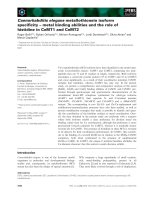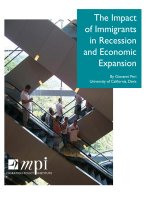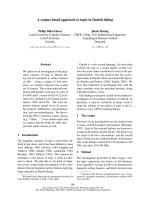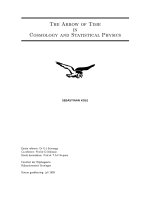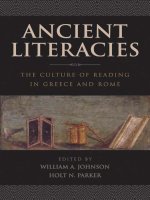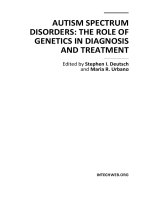The gulf of mexico oil spill a corpus based study of metaphors in british and american media discourse 2
Bạn đang xem bản rút gọn của tài liệu. Xem và tải ngay bản đầy đủ của tài liệu tại đây (872.65 KB, 48 trang )
21
CHAPTER 2
THE CONTEMPORARY DEVELOPMENT OF
CONCEPTUAL METAPHOR THEORY
2.1. Conceptual Metaphor Theory: Origins and development
Conceptual Metaphor Theory (henceforth CMT) is the dominant
paradigm in metaphor studies. The school of cognitive metaphor analysis
founded by Lakoff & Johnson (1980) claims that “metaphors play a central
role in the construction of social and political reality”. According to this
paradigm, Conceptual Metaphors are defined as systematic sets of
correspondences or “mappings” across conceptual domains whereby a more
abstract “target” domain is partly structured by a more concrete and
experiential “source” domain. Thus, CMT in the Lakoff & Johnson tradition
views linguistic metaphors and similes as reflecting mappings across domains
of knowledge that undergird the language user’s understanding of the world in
which they live. Lakoff & Johnson go as far as to claim a strong version of
CMT that sees metaphorical thought in the form of cross-domain mappings as
“primary” whilst metaphorical language is “secondary”. According to the
Conceptual Metaphor paradigm, examples of general metaphors include path-
movement-journey metaphors (“GOOD PROGRESS IS FORWARD MOVEMENT”)
and the strict father vs. nurturing parent model (“MORAL AUTHORITY IS
PARENTAL AUTHORITY”, “A COMMUNITY IS FAMILY” etc.). The basic idea is
that these Conceptual Metaphors have entailments through which they
highlight and coherently organise those aspects of our experience through an
22
experiential or embodied dimension. Thus, in their view, metaphors may
“create social realities for us and become a guide for future action” (Lakoff &
Johnson, 1980). A good example to illustrate this point would be the
“ARGUMENT IS WAR” metaphor where many aspects of arguments are framed
in terms of war e.g. “shooting down arguments”, “launching counter-attacks”,
winning strategies that are “right on target” etc. However, a key criticism of
CMT is that it is founded on a relatively small set of samples that were either
artificially constructed or arbitrarily collected. Thus, one major proposition to
rectify this would be through the adoption of a corpus methodology. When
used in tandem with a systematic and theoretically-sound framework, this has
the potential to put CMT on a sounder empirical and academic footing that
enables the extrapolation of conceptual metaphors from authentic linguistic
data. This thesis aims to extend existing corpus methodology in the
identification and analysis of conceptual metaphors in large datasets through
the use of semantic annotations in WMatrix software and word sketches in
Sketch Engine as an empirical, inductive springboard.
But before we move onto the introduction of the new proposed
framework, it is important to acknowledge the key shortcomings plaguing
Conceptual Metaphor Theory since its inception. The original assumption by
Lakoff & Johnson (1980) that metaphor is a cross-domain mapping in the
conceptual system is being challenged by a variety of theorists – with the key
points of contention coming from Class Inclusion Theory (Glucksberg &
Keysar, 1990; Kintsch, 2000; Jones & Estes, 2005) and Relevance Theory
(Wilson & Sperber, 2002, Moreno, 2005). In response, Gentner & Bowdle’s
(2008) Career of Metaphor Theory attempts to integrate the main concerns
23
raised by arguing that the mental processing behind individual metaphors
“evolve” over the course of their lives from comparison (cross-domain
mapping) in the early stages, to categorisation when they become
conventionalised (p.123). So this means that the standard source and target
domain mapping proposed by Lakoff & Johnson (1980) is increasingly viewed
as over-simplistic as a variety of cognitive mechanisms tend to work in
tandem in order to ensure cognitive efficiency for different metaphors, both
conventional and novel. The main claim is that the Career of Metaphor Theory
offers a sophisticated description of the relation between the cognitive and
linguistic forms of metaphor.
On the other hand, Fauconnier & Turner’s (1997, 2002, 2008)
Conceptual Blending Theory further claims that metaphorical thought is best
represented as a higher level of organisation rather than a simple cross-domain
mapping. This means that metaphorical thought comprises a network of
connected mental spaces that results in emergent structure created by the
blended space and the entire network. Conceptual Blending (also known as the
“network model”) states that these blended spaces are often structured by
more than one conceptual domain or input spaces and these result in a fourth
generic space that makes the sharing of abstract structures possible (Kovecses,
2002, p.227-232). This highlights the importance of the socio-cultural context
as a key-determining factor in the cognitive processing of metaphors, apart
from the usual linguistic and conceptual considerations. These recent
developments in metaphor theory will be taken into account in the proposed
formulation of the new discourse-analytical framework that attempts to
capture metaphor in language, thought and communicative context. This
24
simply means that the representation of the conceptual metaphors mined from
the corpus will include a socio-cultural dimension in addition to the usual
linguistic and conceptual considerations in its interpretation and presentation.
2.2. Previous Studies: Main Trends
This segment aims to provide a chronological overview of the
contemporary development of conceptual metaphor theory from an
amalgamation of selected metaphor theorists. While this overview is by no
means a comprehensive listing of all the significant works by metaphor
theorists, it forms the broad source of inspiration as well as the theoretical
springboard for subsequent development of the Integrated-approach to the
Identification of Conceptual Metaphors (IICM) proposed in this thesis.
2.2.1. An Inductive Approach to the study of Metaphor (Partington,
1998)
Partington’s (1998) key contribution to CMT lies in three main areas.
Firstly, he advocates a distinction between Systematic Metaphors or Source
Metaphors and Genre-Typical Metaphors. Partington notes that Lakoff &
Johnson’s metaphorical concepts e.g. “THEORIES ARE BUILDINGS”, “IDEAS
ARE PLANTS”, “TIME IS A VALUABLE COMMODITY”, fall under the category of
a “semantic mega-metaphor”. His main criticism is that Lakoff & Johnson pay
no attention to the notion of genre or text-type. Thus, Partington proposes that
data from corpora should be accessed according to a number of different
25
mega-genres or text-types e.g. according to different sections of the newspaper
and texts of miscellaneous disciplines in the academic genre in order to
provide an element of representativeness and generalisability to the findings
and interpretations. He feels this distinction ought to be made as metaphor is
“sometimes serious, at others self-conscious and tongue-in-cheek” according
to the communicative context. Thus, Partington highlights the significance of
consistency in the topic and text-type for metaphorical analysis. He proposes
that the analysis has to be taken in conjunction with social, historical and
contextual factors in the identification and formulation of conceptual
metaphors.
His second key contribution would be his support for the use of
authentic data to support theoretical arguments on Conceptual Metaphors. He
advocates the amalgamation of a corpus-linguistic approach together with
CMT. For example, Partington feels that in terms of methodology, it is not
sufficient to refer to the relevant sections of a newspaper in isolation. Hence,
the significance of a metaphor finding must be gauged empirically against a
reference corpus. This is because it is important to make use of a reference
corpus to make a point on the significance of the findings in the targetted text
types through a cross-corpora comparison of the nature and frequency of
metaphors. This approach advocates an empirical foundation for the
formulation of conceptual metaphors that is based on authentic language data
that is not artificially elicited.
Thirdly, Partington supports an inductive approach to data analysis. He
feels that it is paramount to let the data itself suggest the range and types of
metaphors that might be found in a corpus rather than guessing a priori what
26
these might be. Hence, he sees the first step to metaphorical analysis as
necessarily manually parsing the texts through ocular scanning. It is clear that
Partington advocates a brand of Conceptual Metaphor Analysis that is genre-
specific and supports qualitative analysis with quantitative data on metaphor
frequency. This provides a more robust account of the discourse role of
metaphor.
Partington’s theoretical stipulations are encapsulated within this thesis
in the choice of genre (online newspapers), the delimitation of the specific
topic under study (the BP Oil Spill in 2010 ranging from 20 April – 20 July),
the conscious use of the informative writing section of the BNC sampler
within WMatrix as a reference corpus as well as the use of USAS semantic
categories to mine the relevant metaphors systemically and inductively rather
than utilising the traditional method of using intuitively pre-determined search
strings.
2.2.2. Methodological and Theoretical Issues in Researching Metaphor
(Cameron & Low, 1999)
This book comprises a collection of landmark articles by prominent
contemporary metaphor theorists with the main aim of developing an approach
towards conceptual metaphor theory that goes beyond mere theoretical
semantics and involves a “delicate integration of word-sense, syntactic form,
pragmatic context, speaker-listener relationship and goals” (p. xiii).
Cameron (1999) focuses on HOW to operationalise the concept of
metaphor for research of an applied linguistic nature. Hence, she advocates a
27
view of language where the social and cognitive aspects are integral to
formulation of theory and the analysis of data. Such an approach foregrounds
the salience of temporal and contextual factors in the process of metaphor
formulation. Cameron also differentiates between two different levels of
metaphorical analysis:
1. The Theory Level of Analysis focuses on metaphor identification, the
categorisation of metaphor types as well as the goals and logic of
production and interpretation (p.7).
2. The Processing Level of Analysis studies the interaction between the
individuals and their socio-cultural environments in processing
metaphorical language in specific discourses as well as how metaphor
processing can alter conceptual structures and imbue new meanings to
lexical items (p.6).
Hence, Cameron asserts that all conceptual metaphor analysis must take place
in a framework that specifically accommodates different metaphor types and
considers the language in a goal-directed discourse context. This discourse
context should be divided into a local, discourse and global context of
systematicity. Thus, Cameron emphasises the importance of amalgamating the
socio-cultural contexts as well as the relevant discourse goals in the
formulation of conceptual metaphors that is culturally relevant and
comprehensive.
Gibbs (1999) proposes several guidelines in researching and applying
metaphor. One of his key ideas is the need for researchers to acknowledge that
28
their accounts of metaphor are only limited to particular TYPES of metaphor.
Here are Gibbs’ proposed categories for metaphor classification (p.30-36):
1. A IS B/ A IS LIKE B: Refers to the typical cross-domain metaphors and
similes in the traditional form of conceptual metaphor.
2. XYZ metaphors (p.31): Refers to proverbial expressions e.g. the love
of money is the root of all evil; religion is the opiate of the masses; wit
is the salt of conversation.
3. Image metaphors (p.32-34): Used in contexts where mental images
from one source of knowledge are mapped onto another (rather than
inter-domain concept mapping). e.g. my wife whose hair is brush fire,
whose thoughts are summer lightning, American civilisation is like an
orchestra (the symphony of civilisation) etc.
4. Single metaphors (p.34-35): These are metaphors that reflect a
particular entailment of the conceptual metaphor - LOVE IS A JOURNEY.
e.g. we are at crossroads, our marriage is on the rocks, the
relationship is a dead-end street, we can’t turn back now etc.
5. Metonymy (p.36-37): Metaphor involves mapping across two different
conceptual domains whilst Metonymy involves only transfer within
one conceptual domain.
Finally, Gibbs also emphasises the importance of recognising the experiential
dimension of metaphors for the twin communicative aims of vividness and
compactness. Hence, the types of metaphorical manifestations as well as the
29
contextual and cultural dimensions of the issue under analysis will be fully
analysed and examined in this thesis.
Low (1999) identifies the vital need for researchers to ensure that the
data, theoretical framework and the associated methodologies are
representative, suitable and consistent in relation to the topic under study. He
emphasises that the researchers should not oversimplify and generalise the in-
built complexity of conceptual metaphors. I will highlight two key issues in
validating metaphor research that are applicable to the concerns in this thesis.
1. Low identifies the inherent subjectivity in current methods of metaphor
identification by individual researchers. This subjectivity is due to
discrepancies in conceptual metaphor identification criteria as well as
the possibility of over-interpretation due to researcher bias and the
phenomenon of “metaphor hypersensitivity” (p.53). Low claims that
“post-hoc questioning” often leads to artificially increased information
density. This is the reason why a standardised conceptual metaphor
identification procedure that is theoretically-sound needs to be
formulated and continually refined.
2. Secondly, it is vital to use a representative corpus within a delineated
context for the study of metaphors in order for the findings to be
validated accordingly.
Hence, it is clear that the predisposition and the interactions within the target
group in the discourse influences the interpretation of metaphors by the
researcher. This is a key consideration in the selection of the respective
30
broadsheets from America and Britain respectively, where the target readers
will perceive themselves either as victims or as wronged perpetrators
depending on their respective end of the spectrum. This will be coupled with
the proposed development of a semi-automated metaphor identification
procedure from a large representative corpus in order to ensure increased
metaphorical validation by reducing the element of researcher bias.
2.2.3. Metaphorical Entailments and Political Legitimation –
(Chilton, 1996; 2004)
Chilton (1996) examines the use of metaphor in the political domain
and claims that political leaders are viewed as persuasive when their
metaphors succeed in legitimising policies. Thus, political leaders use
metaphors that will either present their own policies in a positive light or will
disparage those of their opponents through the media. This makes metaphor an
ideological tool for shaping the political or media landscape. Chilton notes that
a news article evokes its most “compelling cognitions” through the metaphoric
views it takes for granted rather than those it explicitly asserts (p.36).
Chilton adopts a diachronic, top-down deductive approach rather
than a bottom-up inductive approach in examining the three concepts of
security, state and sovereignty in Cold War discourse. He also examines how
these abstract concepts are constructed and mediated through the passage of
time and the changing historical landscape. Chilton has two overarching aims
in this research endeavour:
31
1. To explore and understand the conceptual underpinnings of Cold War
discourse.
2. To trace the historical development of the concepts of security and
containment.
Chilton describes Cold War discourse as a “self-replicating system of
concepts structured in large part by the CONTAINER schema, which is in line
with Western concepts of sovereignty and security and foreign policy
discourse” (p.416). Thus, it can be seen that Chilton adopts the strong view of
CMT that metaphor undergirds human cognition and communication and is a
vital cog for human understanding and behaviour. Chilton further suggests that
power can be thought of in terms of the control of resources, which includes
the discursive power to influence and impose concepts on the basis of
preferred policies favourable to those in power. By using metaphors, those in
positions of power foreground the aspects of the phenomenon favourable to
them and downplay others, therefore potentially affecting the receiver’s views.
The key theoretical contribution in Chilton’s view of Conceptual
Metaphor would lie in the two interconnected aspects of metaphor that he
identifies. Firstly, he highlights the concept of metaphorical entailment. The
main example he utilises is the metaphorical conceptualisation of the state as a
person. The “STATE IS A PERSON” metaphor means that since states are
conceptualized metaphorically as persons – it will be metaphorically entailed
that “states have motives, goals, can be sick or healthy, be weak or strong and
will have the desire to survive or to dominate” (p.57). The use of such
entailments is necessary because policies and decisions, especially difficult
32
ones, have to be seen as legitimate/justifiable by the general public. Chilton
claims that political legitimation cannot be done entirely by the presentation of
quantitative, logical and empirical arguments. Thus, the cognitive–semantic
approach suggests that mental models or entailments play a significant role in
the media and political landscape.
The second interconnected aspect of metaphor is where metaphorical
discourse is seen both as a “constituent and as a product of human interaction”
(p.65). In this view, metaphors are used in interactions to minimise conflict
between parties by enhancing commonalities and downplaying differences as
well as tabooed or threatening subjects. This leaves room for the negotiation
of specific meanings and references on a personal and on a political level.
Thus, Chilton sees Conceptual Metaphors as playing a crucial role at the stage
of articulation since it “acts as a conceptual instrument that enables people to
think about situations that are new, complex or remote” (p.71). Chilton (2004)
stresses three key strategic functions of linguistic actions in politics and the
media:
1. Coercion through the use of resources to influence and dictate agendas
with the threat of force.
2. The legitimisation and delegitimisation of in-groups and out-groups.
3. Representation and Misrepresentation by controlling the nature and
channel of the information while foregrounding particular views of
reality.
33
Hence, metaphorical embedding in discourse means that metaphors
contribute to a situation where they privilege one understanding of reality over
others as dictated by those in control. This is especially important in an age of
electronic media where the circulation of ideas among societies takes place on
an online platform with multiple points of access. This provides the discursive
space for conceptual contestation and transformation through the various
entailments. In the same vein, the metaphors used to frame the conflict
between traditionally staunch allies; America and Britain, in online newspaper
discourse will be examined in order to account for the foregrounding of certain
core issues within the Gulf of Mexico Oil Spill.
2.2.4. The Discourse-Evolution of Metaphors (Musolff, 2004a; 2004b)
Musolff examines the socio-cognitive dimension of metaphor by
examining the phenomenon of “metaphor evolution” in a corpus of British and
German debates about the EU. Musolff tracks the historical changes in the use
of the body politic metaphor and discusses the factors involved in conceptual
variation through time. The analysis examines the historical evolution of
mappings from the LIFE-BODY-HEALTH source domain onto the STATE-
SOCIETY target domain. The corpora used in the study includes EUROMETA 1 –
which includes 2100 passages from 28 British and German newspapers from
1989-2001 as well as EUROMETA 2 consisting of 19,000 texts built from two
general corpora, the COBUILD corpus from the University of Birmingham
and the ‘COMAS’ from the Mannheim Institute for German Language. Hence,
34
this analysis is based in part on broadsheet discourse and provides a good
precursor for this present analysis.
Musolff feels that the conceptual domain and the accompanying
image-schemata often result in a fragmented view of metaphors that is
sprawling and disjointed. Thus, he proposes an alternative hierarchical system
called “scenarios”. According to Musolff, “scenarios” provide the “main
story-lines or perspectives” captured by a cluster of conceptual metaphors, and
can be developed and extended accordingly (p.18). An apt example for this
present study would include the intertwining of the WAR and ILLNESS
scenarios – where Louisiana coastline is often personified either as a patient or
as a victim under siege in the process of containing the oil spill in the Gulf
(Figure 2.1.).
Figure 2.1.
A pictorial representation of Musolff’s hierarchical view of metaphors
Musolff further claims that the “discourse career” of a metaphor
depends on two intertwining factors (p.13):
1. The experiential grounding of the metaphor
Scenario: WAR
Conceptual Metaphor:
THE OIL SPILL IS AN
ENEMY
THE ENVIRONMENT IS A
VICTIM
BP IS A CRIMINAL
35
2. The “conceptual flexibility” that facilitates its salience in scenarios that
deviate from its original conceptualization.
This highlights the importance of the socio-cultural and historical context of
the discourse in determining how the same metaphorical concepts can evolve
and contest against competing concepts in accordance to the specific needs of
the discourse participants.
Musolff also states that a corpus does not provide any cues for the
identification of metaphoricity. It only contains concordances of expressions
that are then subjected to selection and interpretation by the analyst. Hence,
the analyst is left with the monumental task of parsing and identifying the
concordance lines that have the potential to emerge metaphorical. While the
existing methods for conceptual metaphor formulation can be seen as both
“tedious” and “subjective” from the positivist school of thought, the USAS
semantic tags provided by the WMatrix software enables the researcher to
potentially comprehensively pre-identify all expressions worthy of study based
predominantly on empirical suggestion rather than from a purely intuitive
platform. The approach to the mining of semantic domains in Wmatrix in this
thesis is based on an extension of Stefanowitsch’s (2006) strategy of searching
for “target domain” vocabulary encompassed by the empirically salient
semantic domains. This novel use of WMatrix that is a departure from existing
methods, amalgamated with a well-documented methodology would then
potentially result in a procedure that is based on authentic representative texts
and that is repeatable.
36
In the same vein, this thesis aims to find evidence for specific
metaphors used in the competing American and British discourses for the
metaphorical conceptualisation of the BP oil spill. This will be done through
the use of corpus analysis assisted by the integrated WMatrix platform which
exhaustively computes the word frequency profiles, concordances, part-of-
speech annotation and the semantic domains. The size and the
representativeness of the corpus will ensure that the conclusions are drawn
only from empirical discourse data. This frequency measure is captured by the
concept of Log-Likelihood Values where the threshold is set at 6.63
corresponding to 99% significance. This measure of overuse is taken with
reference to the in-built BNC samplers (Rayson, 2005). This simply means
that the Semantic Domains and the accompanying lexical items selected for
analysis are statistically significant or empirically salient as long as the Log-
Likelihood Value is greater than 6.63. Such an empirical analysis can provide
a unique perspective for comparing conceptual metaphors that underlie public
debates in different national cultures. This is especially so in America and
Britain where the historical, geographical and political cultures are closely
related to each other. We can thus see the subtle differences in the conceptual
metaphors used even though the metaphors can be largely similar in range due
to their cultural proximity.
2.2.5. Critical Metaphor Analysis (Charteris-Black, 2004; 2005)
Charteris-Black (2004) is a proponent of Critical Metaphor Analysis
(henceforth CMA). The CMA is an interdisciplinary discourse-analytic
37
approach to the study of conceptual metaphors. It proposes an approach that
integrates linguistic analysis with contextual understanding and social insight
in explaining the use of metaphors. Charteris-Black’s belief is that metaphors
have three distinct yet integrated functions - a “semantic role in creating new
meanings for words, a cognitive role in developing our understanding via
analogy and a pragmatic role that aims to provide evaluations” (p.9). Hence,
Critical Metaphor Analysis is a three-pronged approach that integrates these
three dimensions. Charteris-Black aims to do this by analysing metaphor and
its role in specific corpora in order to produce a “discourse model for
metaphor”. Such a study comprises a thorough analysis of the accompanying
pragmatic factors such as the socio-cultural and communicative context as
well as its persuasive functions in the associated political contexts. Since
metaphors are highly influential in the way they covertly shape our beliefs,
attitudes and actions across social and political domains, a critical stance is
needed for readers to evaluate the intentions of the text producers and identify
the nature of particular ideologies.
Here is Charteris-Black’s approach to identifying and researching
metaphors in the critical tradition (p.244):
1. A search is conducted for “Conceptual/Metaphor Keys”. These are
frequent and relevant metaphorical expressions found in smaller
groups of representative texts.
2. These Metaphor Keys are then concordanced in the target corpus.
3. The analysis of the findings can then be used to extrapolate the
dominant conceptual metaphors in each dataset and draw conclusions
38
on the persuasive, emotive and ideological functions of metaphor in
different societal and cultural domains.
It is important to note that in Charteris-Black’s framework, metaphors are
organised hierarchically in descending order of scope in Figure 2.2 as
“conceptual keys”, “conceptual metaphors” and “linguistic metaphors”
(p.244). The key claim is that such a hierarchical organisation results in a
description of metaphor that is organised and streamlined, rather than a large,
disorganized sprawling entity. This hierarchical model is merely an abstract
inference from linguistic evidence that mainly serves the purpose of
establishing frameworks of coherence in particular discourses. A concrete
example adapted from Charteris-Black can be seen in Fig. 2.3 (p.192). Such a
hierarchical organisation mirrors Musolff’s two-tier framework of a
“Scenarios” and “Conceptual Metaphors” discussed in an earlier segment
(2.2.4). However, the springboard for metaphorical analysis using Charteris-
Black’s procedure remains deductive and predominantly reliant on researcher
intuition. While this does not detract from his excellent findings and well-
delineated methodology, it does pose the possibility of the researcher missing
out on significant conceptual mappings – especially in the analysis of large,
representative corpora. This has the potential to undermine the possibility of a
thorough metaphorical analysis.
39
Fig. 2.3.
An example of Charteris-Black’s hierarchical view of metaphors: Metaphor in the
Bible (p.192)
However, Charteris-Black’s key contribution lies in his critical
approach to metaphorical analysis. Charteris-Black’s methodology for Critical
Metaphor Analysis is encompassed in the following five steps (p.34):
1. Identifying candidate metaphors through ocular scanning of a smaller
representative sample of texts.
2. Qualitative analysis on whether the selected node word is literal or
metaphorical. A node word is metaphorical if it fulfils the linguistic
criteria of causing a semantic tension, the pragmatic criteria of
Conceptual/Metaphor
Keys
Conceptual
Metaphors
Linguistic
Metaphors
Fig. 2.2.
Charteris-Black's (2004, p.244) hierarchical view of metaphors
HUMANS ARE PLANTS
SPIRITUAL IS NATURAL
PEOPLE ARE FRUIT
(Psalm 127:3)
PEOPLE ARE TREES
(Psalm 92:12)
PEOPLE ARE CROPS
(Matthew 13: 38)
SPIRITUAL GUIDING IS
NURTURING
(Jeremiah 12:2)
Conceptual
Metaphors
Conceptual
Metaphors
Conceptual
Keys
40
intending to influence opinions and judgements by persuasion as well
as the resulting cognitive criteria of a conceptual shift.
3. Use of corpus software to identify frequency and details.
4. Formulating the associated Conceptual Metaphors
5. Generalising the findings to suggest understanding or thought patterns
which have the potential to construct or constrain people’s beliefs and
actions.
A systematic and thoroughly documented approach is vital as it ensures
repeatability and accountability. This is also key for the formulation of a
thorough evaluative framework for analysis that can be critiqued and
improved on in subsequent studies and iterations. However, it is clear that
Steps 1, 2 and 4 remain potentially highly subjective as different researchers
can observe largely differing levels of metaphoricity in the absence of a
procedure that ensures inter-rater reliability. Hence, this thesis aims to suggest
an approach that builds on existing frameworks to increase the reliability of
the entire metaphor analysis procedure.
• Step 1 will be extended through the use of an online concordancing
programme to provide an empirical basis for the pre-selection
procedure - via USAS Semantic Domains and Log Likelihood values
as frequency indicators for overuse. This simply means that the
springboard for the analysis is data-driven and empirical. The broader
theoretical discussions underlying this approach (based on key
elements of Stefanowitsch’s (2006) detailed overview of corpus-based
41
approaches to metaphor) will be described in detail in Section 2.2.7
below.
• Step 2 can be refined through the adoption of a conceptual metaphor
identification procedure that assumes that the lexicon is a reflection of
our underlying conceptual system (Kovecses, 2002) and is based on
the sentential context of the node word .
• Step 3 can be systematised via a lexical approach based on choosing an
empirically salient node word, re-classifying its collocations within the
designated sentential span and grouping them into coherent general
mappings. This process is facilitated by the use of “word sketches” in
Sketch Engine which are essentially corpus-based summaries of a
word’s grammatical and collocational behaviour (Kilgarriff et al.,
2004). In keeping with the empirical tradition advocated in this thesis,
only the most salient collocations will be used as a springboard for
conceptual metaphor formulation. This conceptual metaphor
identification procedure takes Hunston’s (2007) and Lindquist’s (2010)
concerns into account where the identification of attitudinal meaning in
a set of concordance lines must be taken in tandem with the extended
context of the discourse.
• Step 5 can be refined and represented through an amalgamation of
theoretical frameworks such as Grady, Taub & Morgan’s (1996)
concept of metaphorical compounds and metaphorical primitives.
Grady, Taub & Morgan’s representation of metaphorical compounds
and primitives provide a hierarchical snapshot of the metaphorical
complex as a result of the discourse. The hierarchical aspect of the
42
diagram is encapsulated by the size of the circles that essentially
captures the relative frequencies of the range/type of metaphors
formulated from the target discourse. This serves to ameliorate the
concern that in-depth metaphorical analysis necessarily results in a
sprawling complex of metaphors, unrelated to one another.
This proposed method shows that while the identification of conceptual
metaphors may appear subjective, a clearly delineated analytical method , such
as the preliminary framework proposed in this thesis, provides the reader a
formal platform to challenge the resultant metaphor classifications. The
theoretical relevance and soundness of this methodology can be further refined
through subsequent iterations.
Hence, Charteris-Black’s Critical approach will be adapted in a unified
analysis for the purposes of this thesis. However, it is vital that this critical
approach should be complemented by the use of large, representative
specialised corpora. Such corpora provide the extensive collocational evidence
required to make informed extrapolations of conceptual metaphor and the
accompanying evaluative frameworks as they are based on instances of
authentic language use. This will enable us to examine the ideological role of
metaphor in a contextualised discourse framework of persuasion and also
enables us to challenge the formulated metaphors by highlighting what is
suppressed. Thus, the delineation of the topic, timeframe and the political
inclinations of the broadsheet under analysis will be carefully examined and
taken into account in this thesis.
43
2.2.6. The Corpus Approach to the Analysis of Innovative Metaphors
(Deignan, 2005)
Deignan (2005) aims to find out how far a theory of metaphor and
thought can account for the patterns found in natural language. While it is
claimed that conceptual metaphors form the background to our conceptual
systems and are thus, of great importance – the extent and the scope of such
metaphorical framing remains to be definitively quantified. A contemporary
example cited by Deignan would be the reference to a relatively modern term,
the Internet e.g. CONNECTED COMPUTERS ARE NODES IN A WEB (p.16). This is
a metaphorical allusion comparing online connections to a spiders’ web where
there are thin but strong connections between nodes and involve the coverage
of a large area using fine connections.
However, Deignan sees that some metaphors are more culturally
mediated than others due to the differences in experiential embodiment. These
differences boil down to contrasting environmental, socio-cultural and
historical backgrounds in each discursive context. Hence, Deignan identifies
two opposing tendencies in the formulation of metaphors - that the tendency to
map creatively from source to target domains is restrained by an opposing
tendency to “fix and reuse conventionalised strings” (p.213). Thus, the choice
of source domains can differ significantly in accordance to the speakers’
socio-cultural, historical and current preoccupations. This will be examined in
this thesis as the conceptual metaphors used to frame the conflict between two
traditionally strong allies in the Gulf of Mexico Oil Spill in 2010 are studied.
Thus, this thesis will examine how physical experiences and cultures are
44
filtered culturally and contribute inadvertently to a “collective bias in
understanding the world”. The distribution of conceptual metaphors across the
selected subset of American and British broadsheets will showcase the
exploitation of the relevant metaphorical concepts for further analysis.
One of the key contributions made by Deignan is her succinct
classification of the cline between historical and innovative metaphors. This
differentiation effectively showcases the importance of being aware of the
range of metaphorical expressions that are present in “found data” or
language-data in-use. The key criterion is that an expression or a term is
metaphorical if there is the existence of semantic tension arising from the
original literal sense of an entity and the systematic linguistic mapping across
another domain. A pictorial representation is effectively captured in Figure
2.4.
Figure 2.4
The cline between Metaphor and Metonymy (Deignan, 2005, p.39)
Inferences in corpus studies are inevitably drawn from raw empirical
linguistic evidence. This is where Deignan’s notions of a range of
45
metaphorical types will be taken into account for the analysis as it is vital to
have an awareness of the cline of metaphors that are often the result of specific
contextual/experiential factors. Thus, with this awareness in mind, an accurate
metaphor analysis can be accomplished through an amalgamation of a top-
down and a bottom-up approach. The top-down approach is done through
the manual parsing of text samples within the corpus and the intuitive
selection of lexical items from the concordancing programme. Deignan sees
that “trained researcher intuition” is indispensable for the reliable
identification of conceptual metaphors from a corpus. However, such an
approach can potentially result in the overlooking of a significant number of
metaphors embodied within a large corpus. This methodological aspect will be
addressed in this thesis through the proposed novel use of semantic domains
embedded within WMatrix (Rayson, 2005), an integrated online
concordancing programme that provides empirical suggestions pertaining to
the lexical items for analysis on the basis of empirical frequency of overuse.
This reduces the reliance on researcher intuition by introducing the semi-
automated empirical selection of the lexical items.
2.2.7. Extracting metaphors from corpora by searching for target
domain vocabulary (Stefanowitsch, 2006)
Stefanowitsch (2006) sees the corpus-based approach as having
established itself as the “major empirical paradigm” in linguistics (p.1). In this
article, he provides an insightful overview of the methodological problems and
possible solutions to corpus-based research in the field of conceptual


